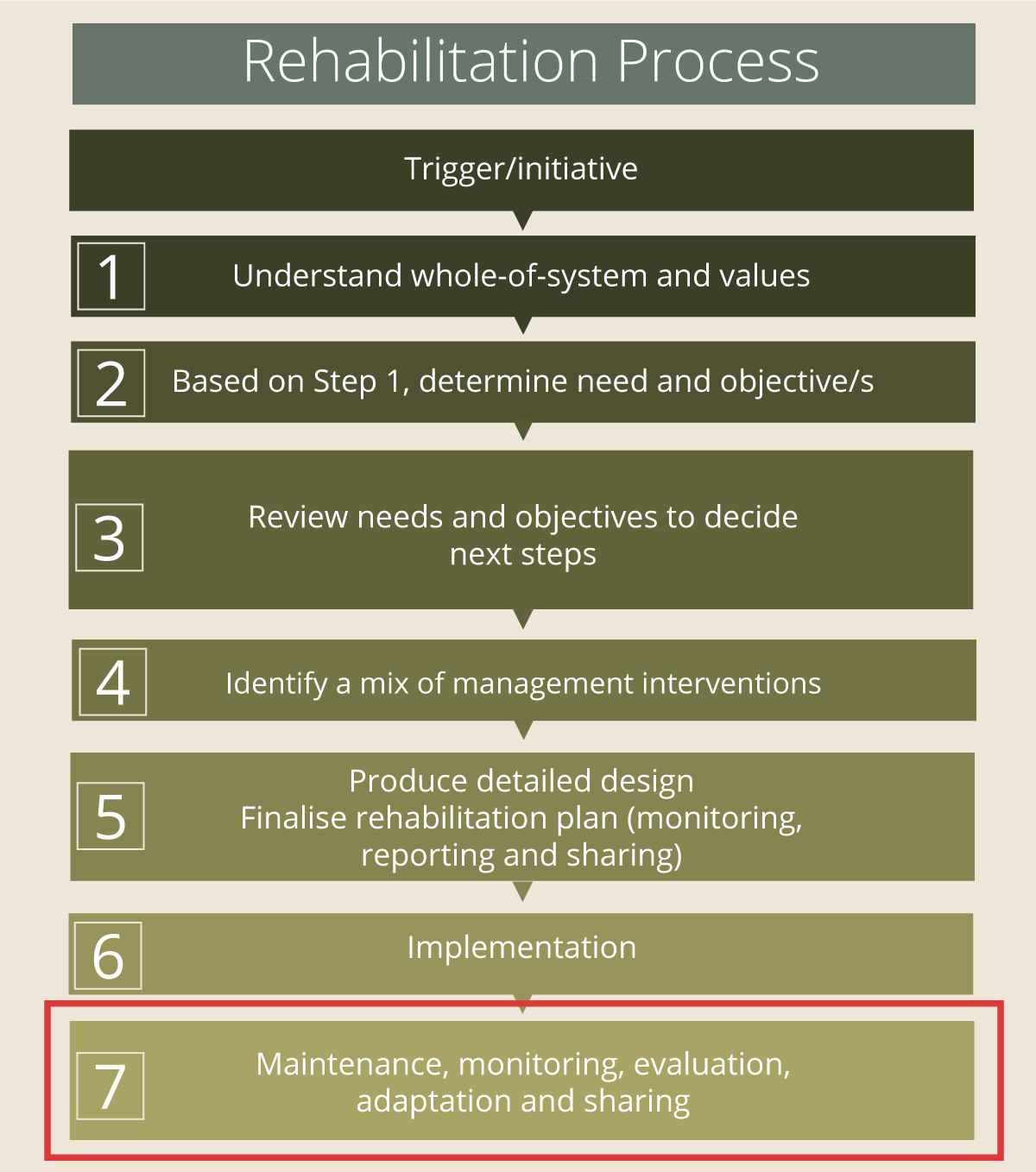|
|
Step 7: Maintenance, Monitoring, Evaluation, Adaptation, and Sharing (MMEAS)After the implementation of the intervention, it is tempting to consider that the project is complete. However, long term maintenance and monitoring is required to evaluate progress towards the objectives. Evaluation will help determine if adaptation of the management approach is required. Once the evaluation has shown clear results these can be shared. Monitoring and maintenance post implementationBiophysical monitoring of site condition should be based around the Condition Assessment Monitoring Plan designed in step 5. Social connections, increased knowledge by local landholders and good working partnerships and collaborations, are critical to project success, however, such social indicators are not included in biophysical assessments. Projects may need to find methods for measuring success of such aspects of a project. Monitoring of project milestones and budget to meet monitoring, evaluation, reporting and improvement (MERI) requirements should be designed around SMART (Specific, Measurable, Achievable, Relevant, and Time-bound) targets created to fit the objective. Maintenance can occur in parallel with monitoring and should be implemented in accordance with the detailed maintenance requirements in step 5. Evaluation of the interventionUsing monitoring results of multiple assessments over time, the project effectiveness can be evaluated. Evaluations should be taken at different times of the project, and these should be guided by the objectives and targets. For example, one-, five-, and twenty-year evaluations may be required to assess the initial project establishment and the medium- and long-term targets. These evaluation milestones are yet another opportunity for sharing. This is a time to share the success and learnings of the project to multiple stakeholders and the community. Explain using data and other visual tools, such as photographs, why the site looks the way it does and suggest the trajectory it may take. While monitoring and evaluation can be undertaken for a single project, there may be efficiencies in combining the process with other projects or as part of the maintenance schedule. There may also be opportunities to collaborate with universities, Government and Natural Resource Management groups and the community including First Nations people to monitor and evaluate projects. Adaptation of the interventionThe evaluation may trigger additional maintenance of the site and/or adaptation of management activities (adaptive management). Evaluation can be used to determine whether the intervention is still appropriate to achieve the outcome. If objectives are not being met, consider if a different approach is required. It is often tempting to continue what was started, especially when using a well-established method, however if it isn’t being effective the project needs to be able to adapt. Sharing successes and learningsSharing of information is frequently missed from the final stages of a rehabilitation project. Consider who needs to know and understand the rehabilitation project and its progress. Let them know what did and did not work well as well as unexpected outcomes. There may be specific reporting requirements based on the funding arrangements for the rehabilitation. However, the benefits from the project can extend further than the landholders, those responsible for the rehabilitation plan, and the funding agency. The overall management recommendations and outcomes of the project are often appropriate to share widely. Rehabilitation sites are generally limited to willing landholders. This can create a patchwork of adopters, lowering the overall impact of each of the individual projects because of a lack of spatial continuity and extent. At a local scale sharing positive outcomes can help more reluctant landholders see the benefits of rehabilitation. Anticipate this type of results sharing in how the site is monitored, evaluated, and reported on to save time and effort. Sharing of information should be encouraged during all stages of the rehabilitation process as this can ensure transparency and the uptake of adaptive management approaches. Sharing when the project did not achieve the intended outcomes can be hard, especially when this could make the project look like a wasted investment. But sharing this information where possible should be championed as it could avoid similar outcomes in the future and alternative options may be suggested. See what others have done via the Project Search Tool. Reflecting on the whole-of-system goalsIndividual interventions may not make a significant difference to components, processes, services and values at the whole-of-system. However, like Step 1, it is important to consider the whole-of-system in the evaluation and sharing of the project. When viewed in the context with other interventions in the system, how significant is the project and how does it contribute to the improvement of the system overall? A summary of the key steps used in the maintenance, monitoring, evaluation, adaptation, and sharing (MMEAS) approach
Last updated: 30 June 2022 This page should be cited as: Department of Environment, Science and Innovation, Queensland (2022) Step 7: Maintenance, Monitoring, Evaluation, Adaptation, and Sharing (MMEAS), WetlandInfo website, accessed 8 May 2025. Available at: https://wetlandinfo.des.qld.gov.au/wetlands/management/rehabilitation/rehab-process/step-7.html |

 — Department of the Environment, Tourism, Science and Innovation
— Department of the Environment, Tourism, Science and Innovation


